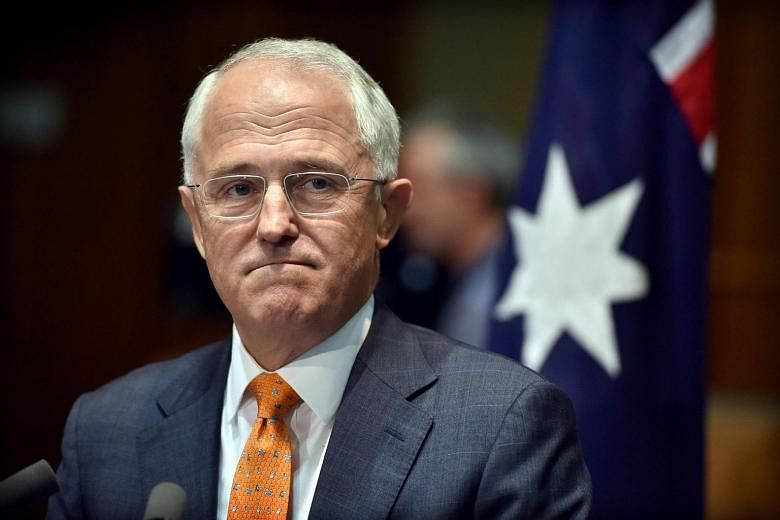After six years of dramatic infighting in Australian politics, the nation's general election on July 2 was widely expected to restore some much-needed stability.
But the voters did not follow the script. Instead, the Prime Minister, Mr Malcolm Turnbull, went close to losing his majority and his Liberal-National Coalition suffered a swing of more than 3.3 per cent. He finally declared victory on Sunday and is likely to end with a tiny parliamentary majority, but the end result remains too close to call.
It was a surprisingly poor performance for Mr Turnbull, a former investment banker who was expected to win comfortably and provide Australia with economic and political stability.
Far from providing a tonic to soothe global nerves following the recent drama of Britain's Brexit vote and the rise of Mr Donald Trump in the United States, Australia's elections seemed to add to the high drama that appears to have swept across Western democracies.
And so the era of instability in Canberra continues. Most commentators believe Mr Turnbull may struggle to remain leader for an entire term and is at risk of joining the growing list of recently ousted Australian prime ministers.
In the past six years, three duly elected leaders - Mr Kevin Rudd, Ms Julia Gillard and Mr Tony Abbott - have been swiftly deposed after opinion polls showed they were at risk of losing an election. Australia had just four prime ministers between 1975 and 2007, but there have been four more in the nine years since.
There were other, somewhat more troublesome surprises at the elections. Perhaps the biggest shock was the return of controversial right-wing firebrand Pauline Hanson, who not only won a seat in the Senate, but is also expected to pick up two more for her anti-Islam One Nation party.
A record 23 per cent of voters opted for smaller parties and independents. These included the Greens and a new party led by a popular independent MP, Mr Nick Xenophon, who campaigned to curb foreign investment and promote Australian manufacturing.
In the Senate, the Coalition will be forced to deal with an odd assortment of independents and so-called micro-parties. This odd bunch will hold the balance of power and could make it immensely difficult for the government to control the legislative agenda.
Increasingly, it seems that political instability has become the new norm in Australia. It is a surprising predicament in a country which has enjoyed 25 years of continuous growth - more than any other nation.
But the Australian breed of instability appears to be different from the wave of recent resentment-fuelled populism in the US, Britain and Europe. It has been fuelled in large part by a drift away from the main centrist parties - and, it seems, they have only themselves to blame.
Despite the poor showing by the Coalition at the elections, the Labor opposition party had little reason to gloat. It received a direct vote of only 35 per cent, its second-worst performance in more than 60 years.
About 77 per cent of voters at this election opted for the big parties - a far cry from 40 years ago, when more than 95 per cent of Australians voted for either Labor or the Coalition.
Membership of the big parties has plunged in recent decades and people are less inclined to hold lifelong political allegiances.
But Australian populism has not completely mirrored the right-wing anti-migrant strain seen recently in Europe, Britain and the US.
Certainly, there is a large contingent of angry, disaffected voters who feel that Canberra has let them down. Many are in rural areas or outer suburbs of larger cities which have been hit by hard times; it was in these places that the Coalition suffered some of its biggest swings.
Ms Hanson's success was strongest in the state of Queensland, where she has long had a strong following. Voters there have a history of backing small, unorthodox populist parties.
But the populist shift did not just benefit far-right anti-migrant advocates such as Ms Hanson.
The other standout success was Mr Xenophon, whose party could win four seats. His support came mainly in the state of South Australia, which has been hit hard by the demise of the mining and car manufacturing industries.
Like Ms Hanson, he is a charismatic, headline-grabbing politician. But he is socially liberal and strongly supports the rights of refugees and migrants.
There is another reason to explain the recent rise of Australia's micro-parties: the recent infighting and ego-based clashes that have dominated both the Labor and Liberal parties.
At each of the past three elections, Australian voters elected a prime minister and then found themselves governed mid-term by a new leader installed by the party.
Despite differing philosophical bases, the opposing sides in Canberra are largely centrist and share similar overall approaches to steering a free market economy with a strong welfare safety net. Yet they instinctively tend to oppose each other on policy. This can frighten leaders into inaction or force them to appear shrill and defensive.
These failures seem to have rubbed off on large numbers of voters: Not surprisingly, many have preferred to abandon Labor and the Coalition and vote for someone else.
Such voters can probably be won back, and a level of stability could be returned to Canberra: But this will depend on whether the current parties and leaders can weather poor polls or bad headlines and demonstrate unity and consistency. There has been little evidence in recent years that they can - and the fractured nature of the incoming Parliament will only make the task harder.


